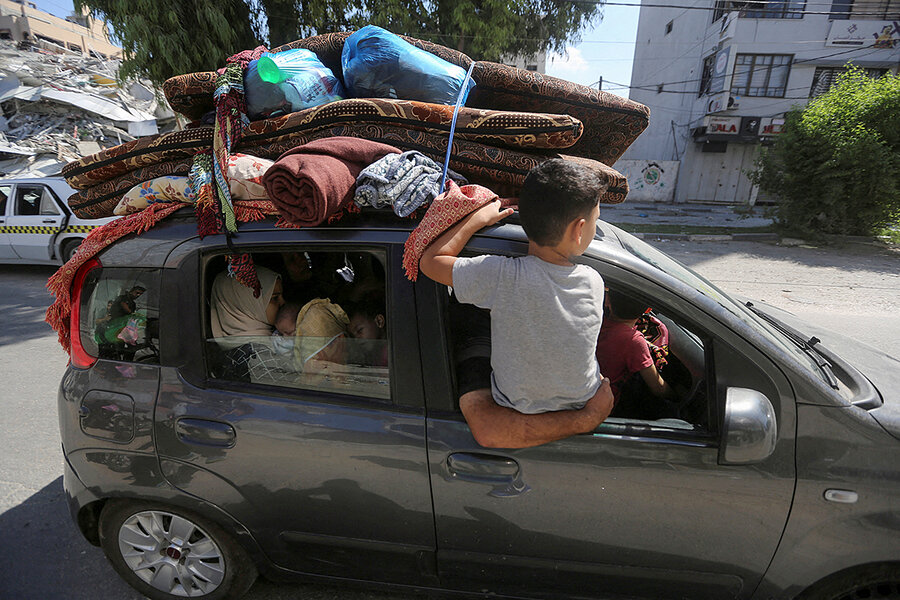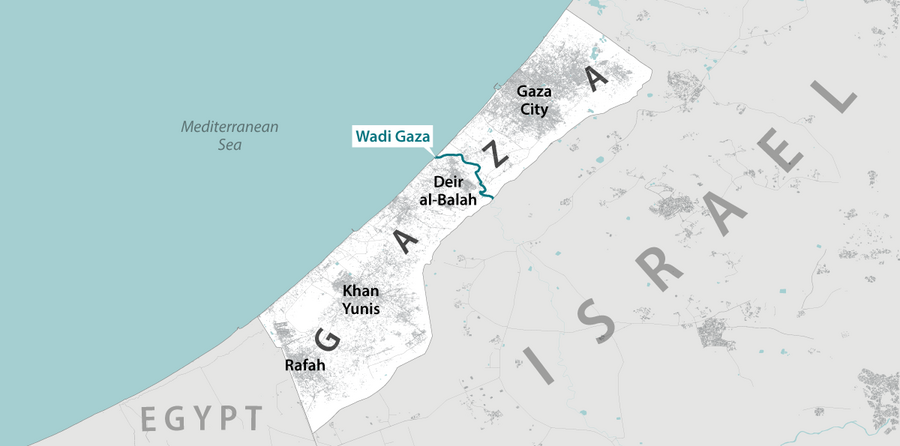To stay or go? Bombarded by Israel, Gazans make anguished choice.
Loading...
| Gaza Strip; and Ramallah, West Bank
Should I stay or should I go? Can I find a way out? Is anywhere safe?
As Israel bombarded the Gaza Strip Friday and gave 1.1 million Gazans a 24-hour ultimatum to evacuate to the southern end of the besieged coastal enclave, these frantic questions consumed Gazans, with no clear answers – and life-or-death consequences.
Why We Wrote This
A story focused onCaught in the middle of the Hamas-Israel war, and with opposing orders from the combatants, 1.1 million civilians in northern Gaza must decide whether safety means leaving their homes. Our reporter had to make the agonizing choice.
In Gaza City, a sleepless night of bombardment and rumors gave way to a morning of frantic second-guessing and scrambling for transport. Hamas told Gazans to stay put, and the United Nations requested that Israel rescind the decision, calling it both “impossible” and “devastating.”
But those who could Friday packed into cars with little more than the clothes on their backs and drove out of Gaza City. Among them was Monitor reporter Hind Khoudary.
“Because we left early, we made it to Deir al-Balah in 10 minutes,” she writes. “But now there are lines of cars to get out of Gaza City.
“Although Israel told us Deir al-Balah would be safe, within hours of our arrival a house was struck near us. ... I wished I had the time to ... say one last goodbye to my family house, in case it is bombed before I can return.”
Should I stay or should I go? Can I find a way out? Is anywhere safe?
As the Israeli military continued its bombardment of the Gaza Strip Friday and gave 1.1 million Gazans a 24-hour ultimatum to evacuate to the southern end of the besieged coastal enclave, these frantic questions consumed Gazans, with no clear answers – and life-or-death consequences.
In Gaza City, a sleepless night of bombardment and rumors gave way to a morning of frantic second-guessing and scrambling for transport as Israel called on Palestinians to vacate to south of Wadi Gaza, a dividing waterline in the center of the strip.
Why We Wrote This
A story focused onCaught in the middle of the Hamas-Israel war, and with opposing orders from the combatants, 1.1 million civilians in northern Gaza must decide whether safety means leaving their homes. Our reporter had to make the agonizing choice.
Hamas told Gazans to stay put, and the United Nations requested that Israel rescind the decision, which would create the largest single forced displacement the Middle East has seen in decades, calling it both “impossible” and “devastating.”
But those who could Friday packed into cars with little more than the clothes on their backs and drove out of Gaza City.
A steady stream of vehicles along the coastal road leading south from Gaza City midday became an afternoon traffic jam.
“People are packed in the streets, even evacuating on donkey carts,” says Sara al-Saqqa, a surgeon at Al Shifa Hospital. The facility had been one of the lone refuges in the city, and had hosted thousands seeking shelter from airstrikes amid the weeklong bombardment campaign that followed Hamas’ attack on Israel last Saturday.
“Everyone is fleeing. I saw people evacuating; I could not even enter the hospital,” Dr. Saqqa says.
Yet still tens of thousands remained in Gaza City, without cars, fuel, or a destination or acquaintance to stay with in southern Gaza.
In response to the Hamas assault, which killed 1,300 Israelis, mostly civilians, Israel mounted a massive and relentless bombing campaign that had killed 1,799 Gazans as of Friday, leaving no neighborhood untouched and sparking a humanitarian crisis of enormous proportions.
As of late Thursday, before the Israeli ultimatum, 423,378 people had already been displaced by the six days of conflict in the 140-square-mile strip, the U.N.’s Office for the Coordination of Humanitarian Affairs said Friday.
On Friday, Gaza City residents received airdropped flyers in Arabic purporting to be from the Israeli army with a map of Gaza and an arrow pointing south, warning, “Gaza City has become a battlefield. You are to evacuate your home immediately and head to the south of Wadi Gaza.”
“Terrorist organizations have launched a war against the state of Israel,” the flyer said, a copy of which was provided to the Monitor. “For your safety and security, do not return to your homes until further notice from the Israel Defence Forces.”
Hamas, the militant group that controls the strip, urged otherwise.
“We tell the people of northern Gaza and from Gaza City, stay put in your homes, and your places,” Eyad al-Bozom, spokesperson for the Hamas Interior Ministry, was quoted by Reuters as saying in a press conference at Al Shifa early Friday.
“By carrying out massacres against the civilians, the occupation wants to displace us once again from our land,” he said, dismissing the warnings as a “disgusting psychological war.”
The shortages of electricity and fuel, as well as disruptions to the communications network, began to affect Palestinians across the territory, with most Gazans plunged into darkness Thursday evening, without electricity for mobile phones. Israel said the cutoffs were intended to isolate an enemy that was still firing rockets into Israel, yet they were also preventing Gazans from receiving information or reaching what was supposed to be safer territory.
Hind Khoudary escapes with her family
After my third sleepless night on a hospital floor at Al Shifa, I had to make the decision: Do I stay in Gaza City or go south? Do I go with my mother to Rafah, or to Deir al-Balah with my husband, to what was supposed to be relative safety?
At 10:41 a.m., my husband and I, my in-laws, my brother-in-law, sister-in-law, and their daughter, Loli, piled into the car to stay with family friends in the village of Deir al-Balah, 7 miles south of Wadi Gaza.
With only minutes to spare before our planned departure, I grabbed my laptop, phone chargers, my ID, and a bag my mother packed for me.
I stopped by a pharmacy for treatment for an infection from a deep cut in my leg; all they could give me was some gauze.
“We barely have medical supplies; four rolls of gauze is enough,” the pharmacist tells me.
In Gaza City, many gas stations were shuttered. I saw several people begging station managers for fuel.
My husband found one of the last gas stations still open, but the attendant could only provide us with 50 shekels’ ($12.57) worth of fuel – about 8 liters (2.1 gallons) – as part of a rationing cap to distribute fuel to as many people as possible.
Yet many people we know do not even have cars; cars have burned in the missile strikes. Others simply do not know anyone in southern Gaza to stay with. Others still prefer to stay rather than be internally displaced.
My aunt told me she would prefer dying at home, surrounded by her children and grandchildren, than evacuating. This is why thousands are staying put in Gaza City, despite the danger.
Aneel, one of many frantically trying to find a way out, was stranded in Tal al-Hawa, a neighborhood in southern Gaza City. She had been evacuated from her home in Shuja’iyya, east of the city center, after a missile strike earlier this week.
“We can’t find a car to take us to the south; there are no cars and there is no one to take us,” she told my mother in an urgent phone call.
The coastal road leading out from Gaza City to the south, the road farthest from the barrier wall, was covered in dust and cracked from missile strikes. Because we left early, we made it to Deir al-Balah in 10 minutes. But now there are lines of cars to get out of Gaza City.
Although Israel told us Deir al-Balah would be safe, within hours of our arrival a house was struck near us. Hours after we made the journey, three cars carrying families heading south reportedly were struck by Israeli missiles in Wadi Gaza.
I wished I had had the time to grab my favorite blanket from home, and say one last goodbye to my family house, in case it is bombed before I can return.
Health care battle
The U.N. and international humanitarian organizations warned it was impossible to evacuate vulnerable and elderly Gazans and hospital patients from northern Gaza, many of whom rely on life support and mechanical ventilators.
“There are severely ill people whose injuries mean their only chances of survival is being on life support,” said World Health Organization spokesperson Tarik Jasarevic. “Moving these people is a death sentence. Asking health workers to do so is beyond cruel.”
The order to evacuate has proved yet another crisis for local health care workers in Gaza facing an uphill battle.
Palestine Red Crescent Society spokesperson Nebal Farsakh described the situation as “catastrophic,” with hospitals overflowing with patients, medical supplies dwindling, electricity shortages widespread, and health centers flooded with citizens seeking shelter. Paramedics brave airstrikes, and several have been killed in the weeklong conflict.
Over the past week, hospitals have emerged as makeshift shelters as thousands of Palestinian civilians flocked to hospitals in northern Gaza such as Al Shifa and Al Quds, out of the belief that the health centers are now the only safe areas Israel will not strike.
With Israel’s ultimatum Friday, it is unclear whether those safe havens will remain.
Yet despite the challenges and the Israeli ultimatum, the Palestine Red Crescent Society says their health care workers will not “turn their backs” on Gaza City and abdicate their responsibility.
“The decision has been made: We are not evacuating. We are not turning back on our duty. We will stay in our main office in Gaza,” Ms. Farsakh says.
“We cannot evacuate the patients; most of them are not in condition for transfer right now. Al Quds hospital is crowded with displaced civilians, our team, and relocated paramedics,” she adds.
Medhat Abbas, director general of Gaza’s Health Ministry, declared a “collapse” of Gaza’s health system, with overflowing hospitals struggling to treat injured civilians and unable to evacuate them.
“The health sector completely collapsed,” Dr. Abbas says in a phone call from Gaza City cut short by communications disruptions. “People are sleeping on the ground in hospitals, which are overflowing with displaced civilians next to bodies and the injured.”
Hind Khoudary reported from Gaza City and Deir al-Balah, and Fatima AbdulKarim reported from Ramallah. Special correspondent Taylor Luck contributed to this report from Amman, Jordan.











